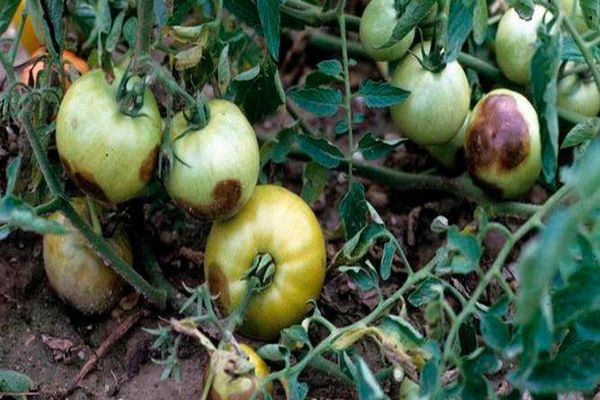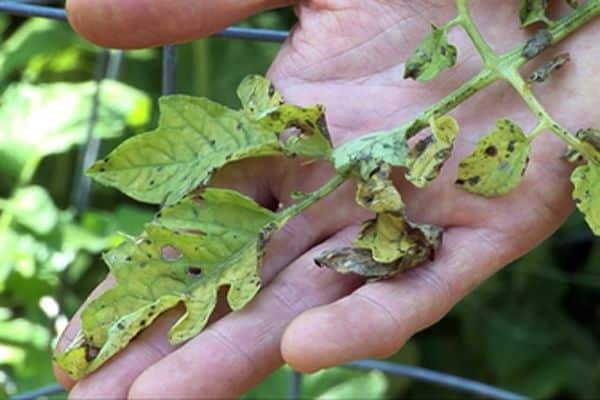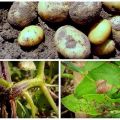Control measures and prevention of stolbur (phytoplasmosis) of tomatoes
It is customary to call a pillar one of the most common gardeners (mostly in the southern regions of Ukraine) and dangerous diseases of tomatoes and other vegetable crops. Usually, infection with this disease has such a detrimental effect on vegetables, including tomatoes, that their yield is sharply reduced by half, or even more. How can you identify a tomato column, and what control measures will help to cope with it?
How does stolbur affect infected tomatoes?
The appearance of stolbur in vegetables is associated with their infection with the Lycopersicum virus 5 Smith virus, which belongs to the category of phytoplasmic microorganisms. Revealed 2 types of disease:
- causes the appearance of stripes on the fruit;
- leads to a change in the color of the foliage to an anthocyanin color.
With a large number of pathogens in the plant, this leads to disruption of vital processes that occur in its cells and tissues, which leads to clogging of blood vessels and the development of chloroticity.
Phytoplasmas, as a rule, begin to be located in plant cells along the cytoplasmic membranes. The stronger and more dangerous will be the manifestations of phytoplasmosis and its consequences for tomatoes, the more their cells are filled with harmful phytoplasmic microorganisms. Also, under the influence of stolbur, there is a sharp decrease in the volume of dry substances contained in a vegetable crop, which also worsens the commercial qualities of the fruits obtained.
Symptoms indicating phytoplasmosis in tomatoes
Typically, the manifestation of stolbur occurs on the foliage, flowers and fruits of tomatoes. At the beginning, the color of the plant stems changes: the tops, shoots, and then the lower leaves of tomatoes become pinkish-purple, which is due to the high content of anthocyanins in the cells.

The foliage of diseased vegetable crops becomes small in size, chlorotic, it curls upward, as a result of which the leaves of the tomatoes acquire the shape of a boat. Due to the fact that the tissues are overflowing with starch, the roughness and fragility of the foliage and stems is noted.
Deformation of the affected tomato flowers begins, an increase in sepals in size, which often can still grow together at the same time, as a result of which, the shape becomes similar to bells. The stamens and pistils cannot develop sufficiently, while the petals become small, colorless or greenish.
Important! Such infested flowers are usually sterile, but if they do produce fruits, then only small, woody with an uneven color.These tomatoes are forbidden to eat.

In what ways can the stolbur spread?
Phytoplasmosis is an extremely Western disease, the spread of which is due to sucking insects, for example, various types of cicadas. In the winter season, mycoplasmas, which are unicellular microorganisms of the causative agent virus, can persist for a long time in the root systems of perennial weeds, namely, milk, plantain, etc.
Important! Cicadas larvae are also usually hibernated there, which, eating the juice of diseased plants, become infected by the virus themselves. In the middle of summer, adult insects begin to settle and, accordingly, infect weeds and vegetables with phytoplasmosis.

The rate of development of mycoplasma and its activity changes every year, which is associated with a change in the wintering conditions of insects carrying the disease. If climatic conditions do not have a favorable effect on the rate of development, reproduction and the process of migration of vectors (for example, in the area with very cold and little snowy winters), the harmfulness of the tomato stalk decreases. The opposite effect is observed in areas with high air and ground temperatures.
What are the ways to combat phytoplasmosis
There are no measures to combat tomato stolbur. When a plant is already infected with a disease, it will not be possible to cure it, all that remains is to get rid of the diseased bush as soon as possible in order to protect the rest of the plants.
For this reason, tomato stolbur is recommended to be prevented by taking some preventive measures.

These include:
- disinfection of seeds - they should be kept for 20 minutes. in water, which was preheated to 50 degrees, or disinfect them using a one percent solution of potassium permanganate;
- it is necessary to carefully observe the norms of spatial isolation of tomatoes and other vegetable crops among themselves - the distance between the sites should be at least 500 m;
- you need to do it on time and regularly mulching the soil under the tomatoesusing straw as mulch in the aisle;
- carry out activities that are primarily aimed at increasing the rate of fruiting of tomatoes (for example, correctly selected top dressing during this period), in order to be able to collect most of the harvest before the disease appears;
- periodically, as needed, to fight weeds that accumulate infection in themselves, and to do this both in the field and on the roadside;
- you can spray tomatoes with insecticides to combat sucking insects, which carry the disease (three times during the growing season of the plant).
In conclusion, it should be noted that you need to properly monitor and care for vegetable crops, including tomatoes. As a result, it will be possible not only to count on large volumes of tomato harvest, but also to prevent infection of plants with various dangerous diseases.
If you follow the recommendations above regarding preventive measures, then you can not be afraid that the tomatoes will suddenly show signs of phytoplasmosis. Vegetable crops will actively develop and delight the gardener with abundant tomato harvests for a long time.









